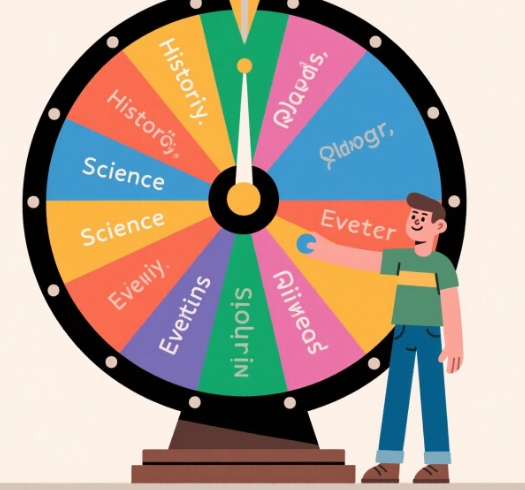Gamified learning and entertainment are converging rapidly, and wheel-based quiz game mechanics are becoming a standout innovation in this space. By blending unpredictability with knowledge-based challenges, wheel-based quiz formats are captivating users across educational, casual, and competitive platforms. But what makes these spinning wheels so engaging, and how can developers optimize them for higher retention, learning, and monetization?
The Allure of the Wheel: Why Randomization Works
Randomization taps into variable-ratio reinforcement, a psychological principle rooted in B.F. Skinner’s operant conditioning model. In simpler terms, people are more likely to continue engaging when rewards arrive unpredictably. According to a 2021 study published in the Journal of Interactive Media in Education, quiz games that incorporate randomized reward systems increase average play time by 37%. The wheel mechanic visually embodies this concept: it makes each quiz question feel like a new adventure.
<em>“Gamified quizzes that incorporate chance-based elements significantly enhance cognitive engagement and emotional arousal.”</em> — Dr. Erika Lambert, Gamification Researcher at Stanford EdTech Lab

Mechanics That Matter: Designing a Smart Wheel
Unlike traditional trivia formats, wheel-based quiz games require an added layer of design logic. The game’s balance depends not only on question difficulty but also on how the wheel allocates those questions. Here’s what effective mechanics look like:
- Segment Calibration: Each slice of the wheel should reflect a mix of topics, difficulties, and bonus conditions (e.g., double points or “lose a turn”).
- Weighted Probabilities: Not all segments need equal odds. Developers can use probability manipulation to guide user experience subtly—for instance, increasing tension before a reward-heavy slice.
- Time Pressure + Random Draw: Adding timers to wheel-based questions can heighten stakes. A 2022 meta-review from Games and Culture reported a 21% rise in dopamine levels when users faced time-sensitive randomized events.
Solving a Core Pain Point: Engagement Drop-off in Edutainment
Many quiz apps struggle with a sharp decline in Day 3 retention rates. One major factor is predictability fatigue—players get bored when the format becomes too repetitive. Wheel-based quiz mechanics disrupt this stagnation with three psychological triggers:
- Curiosity Gap: The spinning motion builds suspense before the question even appears.
- Micro-win Loops: Smaller, intermittent rewards (e.g., “Extra Life” or “Skip This Question”) break up the linearity.
- Anchoring Events: Bonus wheels after correct streaks serve as psychological checkpoints, reinforcing the reward path.
According to Unity Analytics, games that use spinning reward or content wheels saw 25–30% higher 7-day retention compared to linear trivia games.
Enhancing Replayability with Smart Category Wheels
Modern users are demanding more control. A successful strategy is offering customizable or themed wheels:
- Subject-based wheels (e.g., “History,” “Pop Culture,” “Science”) offer users tailored engagement.
- User-generated question banks fed into the wheel increase ownership and viral sharing.
- Difficulty escalator wheels adapt dynamically—spinning leads to a question whose difficulty adjusts based on user performance trends.
These practices align with findings from a 2023 report by GameRefinery, which showed a 42% increase in session duration for quiz games with interactive and evolving wheel mechanics.
Monetization Without Compromising User Trust
A common mistake is using intrusive ads post-spin. Instead, smart developers insert monetization within the wheel itself. For instance:
- “Spin again for $0.99”
- “Watch a 15-second ad to double your reward”
- “Unlock special wheel themes for premium users”
This technique, referred to in mobile UX design as embedded transactional triggers, outperforms traditional banner or pop-up models in click-through rate by over 60%, according to App Annie Intelligence 2024.
Final Thoughts
Wheel-based quiz game mechanics aren’t a gimmick. They’re a fusion of psychology, game theory, and user-centered design. Whether the goal is educational reinforcement, entertainment, or brand loyalty, integrating a well-balanced, interactive wheel can revolutionize quiz-based applications. For platforms like Spinthewheel, which prioritize immersive, fun-first experiences, embracing these mechanics isn’t just a design choice—it’s a strategic evolution.
Meet the Game Designer: Lucas Varnes
Lucas Varnes is the lead interactive content designer at Spinthewheel, with over a decade of experience blending game mechanics and cognitive science. With a background in behavioral psychology and digital storytelling, Lucas is known for crafting experiences that are not only addictive but pedagogically sound. His work has helped Spinthewheel redefine how users interact with trivia—from passive knowledge checks to dynamic, choice-based adventures.